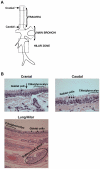Decoding the distribution of glycan receptors for human-adapted influenza A viruses in ferret respiratory tract
- PMID: 22359533
- PMCID: PMC3281014
- DOI: 10.1371/journal.pone.0027517
Decoding the distribution of glycan receptors for human-adapted influenza A viruses in ferret respiratory tract
Abstract
Ferrets are widely used as animal models for studying influenza A viral pathogenesis and transmissibility. Human-adapted influenza A viruses primarily target the upper respiratory tract in humans (infection of the lower respiratory tract is observed less frequently), while in ferrets, upon intranasal inoculation both upper and lower respiratory tract are targeted. Viral tropism is governed by distribution of complex sialylated glycan receptors in various cells/tissues of the host that are specifically recognized by influenza A virus hemagglutinin (HA), a glycoprotein on viral surface. It is generally known that upper respiratory tract of humans and ferrets predominantly express α2→6 sialylated glycan receptors. However much less is known about the fine structure of these glycan receptors and their distribution in different regions of the ferret respiratory tract. In this study, we characterize distribution of glycan receptors going beyond terminal sialic acid linkage in the cranial and caudal regions of the ferret trachea (upper respiratory tract) and lung hilar region (lower respiratory tract) by multiplexing use of various plant lectins and human-adapted HAs to stain these tissue sections. Our findings show that the sialylated glycan receptors recognized by human-adapted HAs are predominantly distributed in submucosal gland of lung hilar region as a part of O-linked glycans. Our study has implications in understanding influenza A viral pathogenesis in ferrets and also in employing ferrets as animal models for developing therapeutic strategies against influenza.
Conflict of interest statement
Figures






Similar articles
-
Glycomic characterization of respiratory tract tissues of ferrets: implications for its use in influenza virus infection studies.J Biol Chem. 2014 Oct 10;289(41):28489-504. doi: 10.1074/jbc.M114.588541. Epub 2014 Aug 18. J Biol Chem. 2014. PMID: 25135641 Free PMC article.
-
Low pathogenic avian influenza isolates from wild birds replicate and transmit via contact in ferrets without prior adaptation.PLoS One. 2012;7(6):e38067. doi: 10.1371/journal.pone.0038067. Epub 2012 Jun 1. PLoS One. 2012. PMID: 22675507 Free PMC article.
-
Hemagglutinin-neuraminidase balance confers respiratory-droplet transmissibility of the pandemic H1N1 influenza virus in ferrets.Proc Natl Acad Sci U S A. 2011 Aug 23;108(34):14264-9. doi: 10.1073/pnas.1111000108. Epub 2011 Aug 8. Proc Natl Acad Sci U S A. 2011. PMID: 21825167 Free PMC article.
-
Glycans as receptors for influenza pathogenesis.Glycoconj J. 2010 Aug;27(6):561-70. doi: 10.1007/s10719-010-9303-4. Epub 2010 Aug 24. Glycoconj J. 2010. PMID: 20734133 Free PMC article. Review.
-
Influence of Host Sialic Acid Receptors Structure on the Host Specificity of Influenza Viruses.Viruses. 2022 Sep 28;14(10):2141. doi: 10.3390/v14102141. Viruses. 2022. PMID: 36298694 Free PMC article. Review.
Cited by
-
Innovations in modeling influenza virus infections in the laboratory.Trends Microbiol. 2012 Jun;20(6):275-81. doi: 10.1016/j.tim.2012.03.006. Epub 2012 Apr 19. Trends Microbiol. 2012. PMID: 22520511 Free PMC article. Review.
-
Unravelling the Role of O-glycans in Influenza A Virus Infection.Sci Rep. 2018 Nov 6;8(1):16382. doi: 10.1038/s41598-018-34175-3. Sci Rep. 2018. PMID: 30401951 Free PMC article.
-
A bovine adenoviral-vector-based universal influenza vaccine confers protection against influenza A and B viruses in mice and ferrets.Mol Ther Nucleic Acids. 2025 Jun 9;36(3):102594. doi: 10.1016/j.omtn.2025.102594. eCollection 2025 Sep 9. Mol Ther Nucleic Acids. 2025. PMID: 40635672 Free PMC article.
-
Quantitative description of glycan-receptor binding of influenza A virus H7 hemagglutinin.PLoS One. 2013;8(2):e49597. doi: 10.1371/journal.pone.0049597. Epub 2013 Feb 20. PLoS One. 2013. PMID: 23437033 Free PMC article.
-
Reduction of Neuraminidase Activity Exacerbates Disease in 2009 Pandemic Influenza Virus-Infected Mice.J Virol. 2016 Oct 14;90(21):9931-9941. doi: 10.1128/JVI.01188-16. Print 2016 Nov 1. J Virol. 2016. PMID: 27558428 Free PMC article.
References
-
- Maher JA, DeStefano J. The ferret: an animal model to study influenza virus. Lab Anim (NY) 2004;33:50–53. - PubMed
-
- Tumpey TM, Maines TR, Van Hoeven N, Glaser L, Solorzano A, et al. A two-amino acid change in the hemagglutinin of the 1918 influenza virus abolishes transmission. Science. 2007;315:655–659. - PubMed
Publication types
MeSH terms
Substances
Grants and funding
LinkOut - more resources
Full Text Sources
Other Literature Sources

